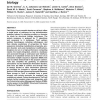116 search results - page 19 / 24 » Feedback Algorithm and Web-Server for Protein Structure Alig... |
103
click to vote
BMCBI
2004
14 years 11 months ago
2004
Background: In a previous paper, we introduced MUSCLE, a new program for creating multiple alignments of protein sequences, giving a brief summary of the algorithm and showing MUS...
87
Voted
NIPS
2008
15 years 1 months ago
2008
Large-margin structured estimation methods minimize a convex upper bound of loss functions. While they allow for efficient optimization algorithms, these convex formulations are n...
97
Voted
SSDBM
2006
IEEE
15 years 5 months ago
2006
IEEE
Multiple sequence alignment represents a class of powerful bioinformatics tools with many uses in computational biology ranging from discovery of characteristic motifs and conserv...
111
click to vote
NAR
2008
14 years 11 months ago
2008
TarO (http://www.compbio.dundee.ac.uk/taro) offers a single point of reference for key bioinformatics analyses relevant to selecting proteins or domains for study by structural bi...
BMCBI
2008
14 years 11 months ago
2008
Background: Amino acids responsible for structure, core function or specificity may be inferred from multiple protein sequence alignments where a limited set of residue types are ...




